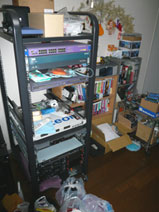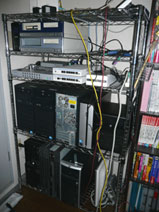au HOME SPOT CUBE2 開封記
2015年4月12日(日) 01:22 JST
閲覧数 32,308
auから、HOME SPOT CUBE2が4/10に発売されました。
今回は無料でのレンタルではなく、販売になっています。
オンラインショップでは、4/11時点で在庫なし。
auショップでは売れてないのか、それなりに在庫あるみたいです。
今回は販売なので、そんなに入れてないとの店員の話でしたが、果たして売れるのだろうか?
さっそく、auショップで購入してきた訳ですが、他に購入者は見当たらず。
店舗在庫はすぐに切れそうになかったので1個だけ買ってきました。
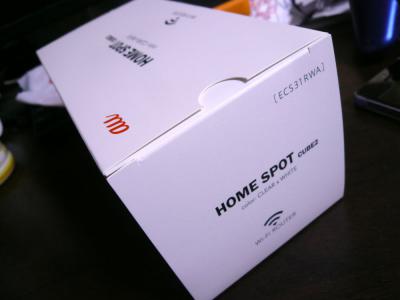
いつもの様に開封記を書いておきますね。
パカっとなぁ。
まず、値段ですが結構します。8,424円。
ほぼ同じカタログスペックの製品が買えてしまうお値段ですね。(今後キャンペーンで安くなるのではないだろうかと予想)
カタログスペック的には、有線はWAN、LANで各1ポート(WAN側は1000BASE-T、LAN側は100BASE-TX)、無線は802.11ac 2.4GHz帯、5GHz帯に対応で、最大866Mbps。
最近ありがちな11ac対応ルータのスペックですかね。
LAN側も1000BASE-Tならよかったのに。(ホームページには100だなんて書いてなさそうだったが)

箱は予想以上にでかいです。

説明書、保証書はお決まりのパターンでしょうか。
あまり個人的に興味ないので以上。
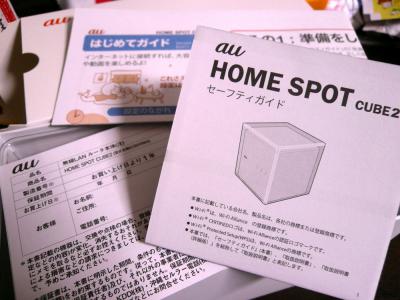
ACアダプタも本体色に合わせ白です。
出力DC 10.5V、1.5A。
12V製品が多いので少し違和感が。
(ちなみに一世代前のHOME SPOT CUBEは5Vです。)
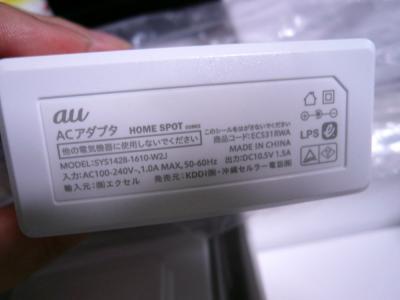
ちなみに付属のLANケーブルも白です。
白で統一してきましたね。
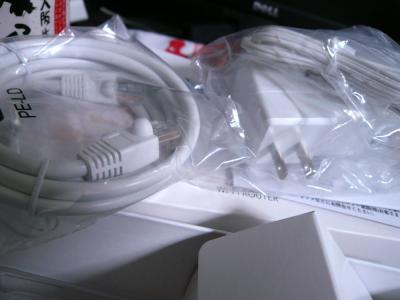
では、CUBE2本体にまいります。
本体のデザインは、一世代前と似ていますが、サイズは一回り大きくなります。
今回は上部にWPSボタン等もありません。
LEDも前面に3個並ぶ形となりました。
前の光るのが結構好きだったので少し残念です。
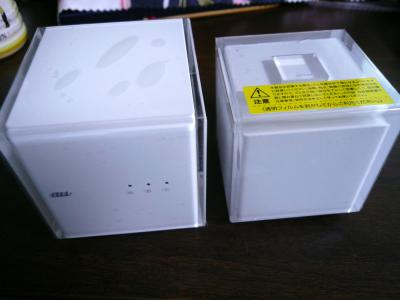
WPSボタンは裏面に移動。まぁこれが普通ですよね。(というか一回しか使わないんだからこれでいいでしょw)
しかし、ポートの所の印刷が、インターネットとパソコンになってます。(WAN、LANとしていないのは、PC初心者を意識したからなのでしょうか。)
でもパソコン側はシールが張られ、「パソコンなど」になっています。
まぁ、パソコン以外も繋げるだろう事を考えるとそうなのですが。。。
で、USBポートが追加されたのは今回大きいですね。
おそらく、ストレージをつないだりプリンタを繋いだりを想定しているのでしょう。と思ったのが間違いでした。
マニュアルに以下の様な記載が。。。
USBポートは当社によるメンテナンスに利用します。
外付けハードディスクなどの機器を接続してもご利用になれませんので予めご了承ください。
また、当該ポートへの接続は故障の原因となりますのでご遠慮ください。
これは絶対つなげる人居る筈。
せめて、microUSBとかにすれば繋げてしまう人は減るんじゃなかろうか。。。
回路を追いかけてないので解りませんが、シリアル通信でもできる様になってるか、ファーム書換え用だったりするんですかね。(後でじっくり見てみる予定)
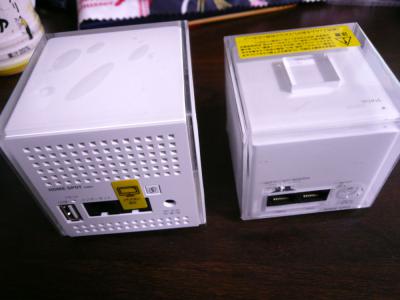
パスワードは個別なのかもしれない。
ランダムっぽい文字列になってました。
1個しか入手しなかったので実際どうなのかは不明。(どなたか入手していたら。。。)
製造は、中国です。
輸入元は、株式会社エクセル。(よくわかりません。)
製造元は、ASKEY COMPUTER CORP.
なにやら、Buffaloの一部機種に関わってる様な情報が見られるので、何気に僕も一台ぐらいは持ってたのかもしれない。
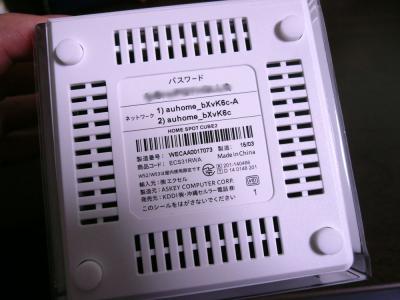
本体前面。
LEDの各ラベルはA、B、C。
マニュアルには、
A:電源の状態
B:インターネットの状態
C:PPPoEの状態
ごめんなさい、A、B、Cじゃ僕にはわかりにくいです。
PC初心者を意識したらこうなったのでしょう。おそらくそうなのでしょう。
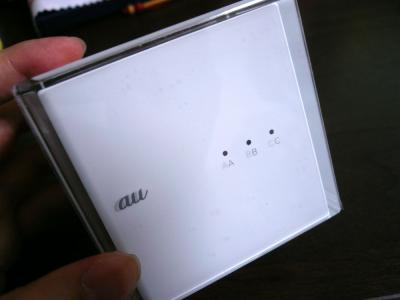
裏面のシール「パソコンなど」は、なぜ貼ったのか。
既に書きましたが、このUSBポートは果たしてどうなっているのか愉しみです。
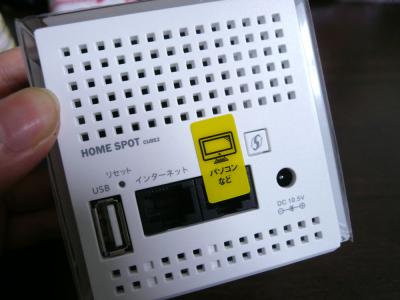
開封自体にはT6のレンチが必要になります。
穴が深くて細いので、レンチの方が良いです。
ネジが埋まってるのは3箇所で、1箇所はダミーです。
ゴムは結構長いのが入ってます。
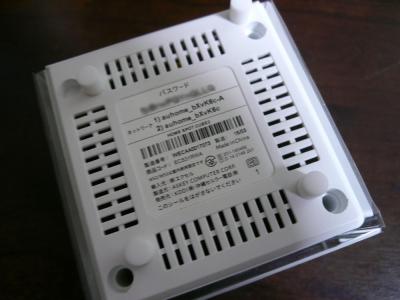
開けると予想外。でかいヒートシンクが登場。
なにを付けてる。。。
剥がそうかと思ったが、シリアル繋いだら大体の構成が解ったので辞めました。
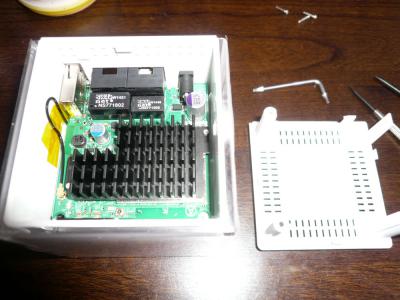
蓋の爪箇所はこんな感じです。開封時の参考に。
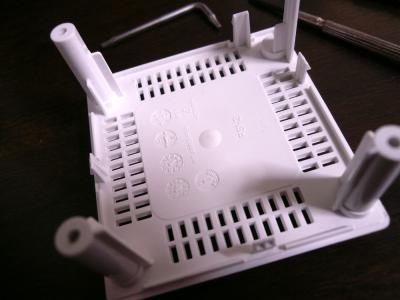
基板取り出す前にアンテナ線を外すのをお忘れなく。
結構短いです。
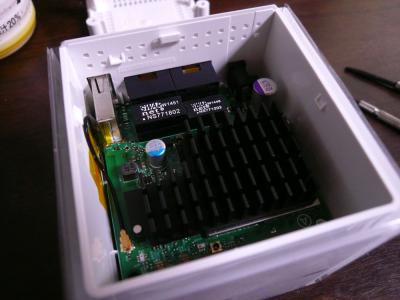
アンテナの片方はケース側面に固定されています。
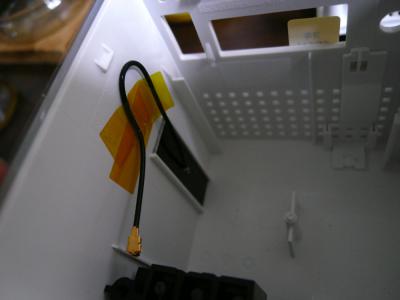
ヒートシンクでガッツリ隠れてしまってます。
結構熱もってる感じなので、ヒートシンクあって正解かもです。
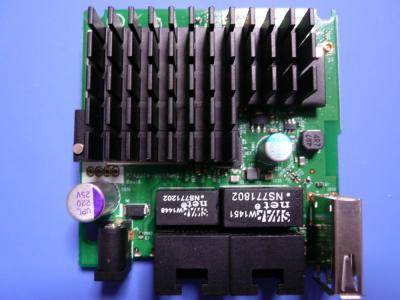
シリアル4ピンのパターンがあるのは嬉しいのですが、ピッチが狭い。
マスト立てる時のピンが。。。
ピン割り当ては、基板外側からRX、TX、GND、VCC(3.3V)です。
ボーレートは、57600。
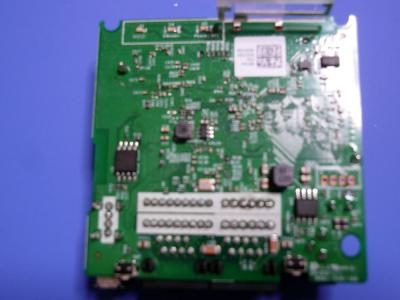
見える範囲の基板シルク印刷からは得に情報は無し。
RT4220W-0111の文字があるが、技適の情報が解るだけ。
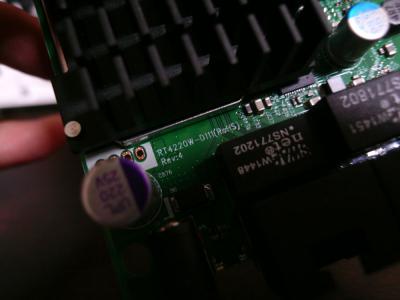
もう片方のアンテナは、透明の板が付いてた。
板が付いてるパターンはあまり見ないけどアンテナ的に何かあるのかな?だた折れない様にってだけなのかな?
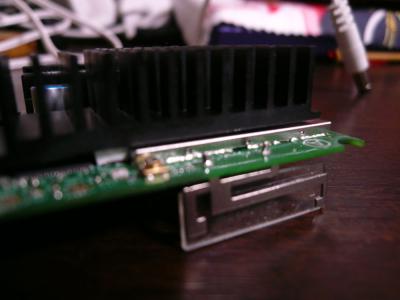
ちなみにヒートシンク外すの辞めたのは、この起動ログ。 rootにはパスワードが付いてるのか入れず。そのうち確認してみよう。
ちなみにこの製品だが、中身これだよね。たぶん。。。
Askey computer corp.の「Cube Router」。
スペック一致するし形も同じ。。。デザイン変えただけやんw
情報がこれぐらいしか見つからないけど。
http://www.computex.biz/PhotoPool2/201503/201503121414212844.pdf
今回は無料でのレンタルではなく、販売になっています。
オンラインショップでは、4/11時点で在庫なし。
auショップでは売れてないのか、それなりに在庫あるみたいです。
今回は販売なので、そんなに入れてないとの店員の話でしたが、果たして売れるのだろうか?
さっそく、auショップで購入してきた訳ですが、他に購入者は見当たらず。
店舗在庫はすぐに切れそうになかったので1個だけ買ってきました。

いつもの様に開封記を書いておきますね。
パカっとなぁ。
まず、値段ですが結構します。8,424円。
ほぼ同じカタログスペックの製品が買えてしまうお値段ですね。(今後キャンペーンで安くなるのではないだろうかと予想)
カタログスペック的には、有線はWAN、LANで各1ポート(WAN側は1000BASE-T、LAN側は100BASE-TX)、無線は802.11ac 2.4GHz帯、5GHz帯に対応で、最大866Mbps。
最近ありがちな11ac対応ルータのスペックですかね。
LAN側も1000BASE-Tならよかったのに。(ホームページには100だなんて書いてなさそうだったが)

箱は予想以上にでかいです。

説明書、保証書はお決まりのパターンでしょうか。
あまり個人的に興味ないので以上。

ACアダプタも本体色に合わせ白です。
出力DC 10.5V、1.5A。
12V製品が多いので少し違和感が。
(ちなみに一世代前のHOME SPOT CUBEは5Vです。)

ちなみに付属のLANケーブルも白です。
白で統一してきましたね。

では、CUBE2本体にまいります。
本体のデザインは、一世代前と似ていますが、サイズは一回り大きくなります。
今回は上部にWPSボタン等もありません。
LEDも前面に3個並ぶ形となりました。
前の光るのが結構好きだったので少し残念です。

WPSボタンは裏面に移動。まぁこれが普通ですよね。(というか一回しか使わないんだからこれでいいでしょw)
しかし、ポートの所の印刷が、インターネットとパソコンになってます。(WAN、LANとしていないのは、PC初心者を意識したからなのでしょうか。)
でもパソコン側はシールが張られ、「パソコンなど」になっています。
まぁ、パソコン以外も繋げるだろう事を考えるとそうなのですが。。。
で、USBポートが追加されたのは今回大きいですね。
おそらく、ストレージをつないだりプリンタを繋いだりを想定しているのでしょう。と思ったのが間違いでした。
マニュアルに以下の様な記載が。。。
USBポートは当社によるメンテナンスに利用します。
外付けハードディスクなどの機器を接続してもご利用になれませんので予めご了承ください。
また、当該ポートへの接続は故障の原因となりますのでご遠慮ください。
これは絶対つなげる人居る筈。
せめて、microUSBとかにすれば繋げてしまう人は減るんじゃなかろうか。。。
回路を追いかけてないので解りませんが、シリアル通信でもできる様になってるか、ファーム書換え用だったりするんですかね。(後でじっくり見てみる予定)

パスワードは個別なのかもしれない。
ランダムっぽい文字列になってました。
1個しか入手しなかったので実際どうなのかは不明。(どなたか入手していたら。。。)
製造は、中国です。
輸入元は、株式会社エクセル。(よくわかりません。)
製造元は、ASKEY COMPUTER CORP.
なにやら、Buffaloの一部機種に関わってる様な情報が見られるので、何気に僕も一台ぐらいは持ってたのかもしれない。

本体前面。
LEDの各ラベルはA、B、C。
マニュアルには、
A:電源の状態
B:インターネットの状態
C:PPPoEの状態
ごめんなさい、A、B、Cじゃ僕にはわかりにくいです。
PC初心者を意識したらこうなったのでしょう。おそらくそうなのでしょう。

裏面のシール「パソコンなど」は、なぜ貼ったのか。
既に書きましたが、このUSBポートは果たしてどうなっているのか愉しみです。

開封自体にはT6のレンチが必要になります。
穴が深くて細いので、レンチの方が良いです。
ネジが埋まってるのは3箇所で、1箇所はダミーです。
ゴムは結構長いのが入ってます。

開けると予想外。でかいヒートシンクが登場。
なにを付けてる。。。
剥がそうかと思ったが、シリアル繋いだら大体の構成が解ったので辞めました。

蓋の爪箇所はこんな感じです。開封時の参考に。

基板取り出す前にアンテナ線を外すのをお忘れなく。
結構短いです。

アンテナの片方はケース側面に固定されています。

ヒートシンクでガッツリ隠れてしまってます。
結構熱もってる感じなので、ヒートシンクあって正解かもです。

シリアル4ピンのパターンがあるのは嬉しいのですが、ピッチが狭い。
マスト立てる時のピンが。。。
ピン割り当ては、基板外側からRX、TX、GND、VCC(3.3V)です。
ボーレートは、57600。

見える範囲の基板シルク印刷からは得に情報は無し。
RT4220W-0111の文字があるが、技適の情報が解るだけ。

もう片方のアンテナは、透明の板が付いてた。
板が付いてるパターンはあまり見ないけどアンテナ的に何かあるのかな?だた折れない様にってだけなのかな?

ちなみにヒートシンク外すの辞めたのは、この起動ログ。 rootにはパスワードが付いてるのか入れず。そのうち確認してみよう。
U-Boot 1.1.3 (Aug 29 2014 - 14:05:39)
Board: Ralink APSoC DRAM: 64 MB
relocate_code Pointer at: 83fb8000
enable ephy clock...done. rf reg 29 = 5
SSC disabled.
spi_wait_nsec: 29
spi device id: c2 20 18 c2 20 (2018c220)
find flash: MX25L12805D
raspi_read: from:30000 len:1000
raspi_read: from:30000 len:1000
============================================
Ralink UBoot Version: 4.2.S.1
--------------------------------------------
ASIC 7620_MP (Port5<->None)
DRAM component: 512 Mbits DDR, width 16
DRAM bus: 16 bit
Total memory: 64 MBytes
Flash component: 16 MBytes NOR Flash
Date:Aug 29 2014 Time:14:05:39
============================================
icache: sets:512, ways:4, linesz:32 ,total:65536
dcache: sets:256, ways:4, linesz:32 ,total:32768
##### The CPU freq = 580 MHZ ####
estimate memory size =64 Mbytes
raspi_read: from:50000 len:40
raspi_read: from:850000 len:40
=================================================
Check image validation:
Image1 Header Magic Number --> OK
Image2 Header Magic Number --> OK
Image1 Header Checksum --> OK
Image2 Header Checksum --> OK
Image1 Data Checksum --> raspi_read: from:50040 len:62b4b8
OK
Image2 Data Checksum --> raspi_read: from:850040 len:62b4b8
OK
Image1 Stable Flag --> Stable
Image1 Try Counter --> 0
Image1: OK Image2: OK
=================================================
Please choose the operation:
1: Load system code to SDRAM via TFTP.
2: Load system code then write to Flash via TFTP.
3: Boot system code via Flash (default).
4: Entr boot command line interface.
7: Load Boot Loader code then write to Flash via Serial.
9: Load Boot Loader code then write to Flash via TFTP.
You choosed 3
0
3: System Boot system code via Flash.
## Booting image at bc050000 ...
raspi_read: from:50000 len:40
Image Name: Linux Kernel Image
Image Type: MIPS Linux Kernel Image (lzma compressed)
Data Size: 6468792 Bytes = 6.2 MB
Load Address: 80000000
Entry Point: 8000c310
raspi_read: from:50040 len:62b4b8
Verifying Checksum ... OK
Uncompressing Kernel Image ... OK
No initrd
## Transferring control to Linux (at address 8000c310) ...
## Giving linux memsize in MB, 64
Starting kernel ...
LINUX started...
THIS IS ASIC
Linux version 2.6.36 (root@davidF13) (gcc version 3.4.2) #18 Mon Jan 26 10:36:29 CST 2015
The CPU feqenuce set to 580 MHz
MIPS CPU sleep mode enabled.
PCIE: bypass PCIe DLL.
PCIE: Elastic buffer control: Addr:0x68 -> 0xB4
disable all power about PCIe
CPU revision is: 00019650 (MIPS 24Kc)
Software DMA cache coherency
Determined physical RAM map:
memory: 04000000 @ 00000000 (usable)
Initrd not found or empty - disabling initrd
Zone PFN ranges:
Normal 0x00000000 -> 0x00004000
Movable zone start PFN for each node
early_node_map[1] active PFN ranges
0: 0x00000000 -> 0x00004000
Built 1 zonelists in Zone order, mobility grouping on. Total pages: 16256
Kernel command line: console=ttyS1,57600n8 root=/dev/ram0 console=ttyS0
PID hash table entries: 256 (order: -2, 1024 bytes)
Dentry cache hash table entries: 8192 (order: 3, 32768 bytes)
Inode-cache hash table entries: 4096 (order: 2, 16384 bytes)
Primary instruction cache 64kB, VIPT, , 4-waylinesize 32 bytes.
Primary data cache 32kB, 4-way, PIPT, no aliases, linesize 32 bytes
Writing ErrCtl register=0003d51f
Readback ErrCtl register=0003d51f
Memory: 55600k/65536k available (3273k kernel code, 9936k reserved, 734k data, 5044k init, 0k highmem)
NR_IRQS:128
console [ttyS1] enabled
Calibrating delay loop... 386.04 BogoMIPS (lpj=772096)
pid_max: default: 32768 minimum: 301
Mount-cache hash table entries: 512
NET: Registered protocol family 16
RALINK_GPIOMODE = 1a371c
RALINK_GPIOMODE = 18371c
PPLL_CFG1=0xe84000
MT7620 PPLL lock
PPLL_DRV =0x80080504
start PCIe register access
RALINK_RSTCTRL = 2400000
RALINK_CLKCFG1 = 75afffc0
*************** MT7620 PCIe RC mode *************
PCIE0 enabled
init_rt2880pci done
bio: create slab at 0
vgaarb: loaded
SCSI subsystem initialized
usbcore: registered new interface driver usbfs
usbcore: registered new interface driver hub
usbcore: registered new device driver usb
pci 0000:00:00.0: BAR 0: can't assign mem (size 0x80000000)
pci 0000:00:00.0: BAR 8: assigned [mem 0x20000000-0x200fffff]
pci 0000:00:00.0: BAR 9: assigned [mem 0x20100000-0x201fffff pref]
pci 0000:00:00.0: BAR 1: assigned [mem 0x20200000-0x2020ffff]
pci 0000:00:00.0: BAR 1: set to [mem 0x20200000-0x2020ffff] (PCI address [0x20200000-0x2020ffff]
pci 0000:01:00.0: BAR 0: assigned [mem 0x20000000-0x200fffff 64bit]
pci 0000:01:00.0: BAR 0: set to [mem 0x20000000-0x200fffff 64bit] (PCI address [0x20000000-0x200fffff]
pci 0000:01:00.0: BAR 6: assigned [mem 0x20100000-0x2010ffff pref]
pci 0000:00:00.0: PCI bridge to [bus 01-01]
pci 0000:00:00.0: bridge window [io disabled]
pci 0000:00:00.0: bridge window [mem 0x20000000-0x200fffff]
pci 0000:00:00.0: bridge window [mem 0x20100000-0x201fffff pref]
BAR0 at slot 0 = 0
bus=0x0, slot = 0x0
res[0]->start = 0
res[0]->end = 0
res[1]->start = 20200000
res[1]->end = 2020ffff
res[2]->start = 0
res[2]->end = 0
res[3]->start = 0
res[3]->end = 0
res[4]->start = 0
res[4]->end = 0
res[5]->start = 0
res[5]->end = 0
bus=0x1, slot = 0x0
res[0]->start = 20000000
res[0]->end = 200fffff
res[1]->start = 0
res[1]->end = 0
res[2]->start = 0
res[2]->end = 0
res[3]->start = 0
res[3]->end = 0
res[4]->start = 0
res[4]->end = 0
res[5]->start = 0
res[5]->end = 0
Switching to clocksource Ralink Systick timer
NET: Registered protocol family 2
IP route cache hash table entries: 1024 (order: 0, 4096 bytes)
TCP established hash table entries: 2048 (order: 2, 16384 bytes)
TCP bind hash table entries: 2048 (order: 1, 8192 bytes)
TCP: Hash tables configured (established 2048 bind 2048)
TCP reno registered
UDP hash table entries: 256 (order: 0, 4096 bytes)
UDP-Lite hash table entries: 256 (order: 0, 4096 bytes)
NET: Registered protocol family 1
Load Ralink Timer0 Module
Load Ralink Timer1 Module
RT3xxx EHCI/OHCI init.
JFFS2 version 2.2 (NAND) (ZLIB) (RTIME) (c) 2001-2006 Red Hat, Inc.
fuse init (API version 7.15)
msgmni has been set to 108
Block layer SCSI generic (bsg) driver version 0.4 loaded (major 254)
io scheduler noop registered (default)
Ralink gpio driver initialized
led=8, on=8, off=8, blinks,=4000, reset=1, time=4000
Serial: 8250/16550 driver, 2 ports, IRQ sharing disabled
serial8250: ttyS0 at MMIO 0x10000500 (irq = 37) is a 16550A
serial8250: ttyS1 at MMIO 0x10000c00 (irq = 12) is a 16550A
brd: module loaded
deice id : c2 20 18 c2 20 (2018c220)
MX25L12805D(c2 2018c220) (16384 Kbytes)
mtd .name = raspi, .size = 0x01000000 (0M) .erasesize = 0x00000010 (0K) .numeraseregions = 65536
Creating 6 MTD partitions on "raspi":
0x000000000000-0x000001000000 : "ALL"
0x000000000000-0x000000030000 : "Bootloader"
0x000000030000-0x000000040000 : "Config"
0x000000040000-0x000000050000 : "Factory"
0x000000050000-0x000000800000 : "Kernel"
0x000000850000-0x000001000000 : "Kernel2"
rdm_major = 253
SMACCR1 -- : 0x0000b4ee
SMACCR0 -- : 0xb4a50dd1
Ralink APSoC Ethernet Driver Initilization. v3.0 256 rx/tx descriptors allocated, mtu = 1500!
SMACCR1 -- : 0x0000b4ee
SMACCR0 -- : 0xb4a50dd1
PROC INIT OK!
PPP generic driver version 2.4.2
NET: Registered protocol family 24
PPTP driver version 0.8.5
usbcore: registered new interface driver asix
usbcore: registered new interface driver cdc_ether
ehci_hcd: USB 2.0 'Enhanced' Host Controller (EHCI) Driver
rt3xxx-ehci rt3xxx-ehci: Ralink EHCI Host Controller
rt3xxx-ehci rt3xxx-ehci: new USB bus registered, assigned bus number 1
rt3xxx-ehci rt3xxx-ehci: irq 18, io mem 0x101c0000
rt3xxx-ehci rt3xxx-ehci: USB 0.0 started, EHCI 1.00
hub 1-0:1.0: USB hub found
hub 1-0:1.0: 1 port detected
ohci_hcd: USB 1.1 'Open' Host Controller (OHCI) Driver
rt3xxx-ohci rt3xxx-ohci: RT3xxx OHCI Controller
rt3xxx-ohci rt3xxx-ohci: new USB bus registered, assigned bus number 2
rt3xxx-ohci rt3xxx-ohci: irq 18, io mem 0x101c1000
hub 2-0:1.0: USB hub found
hub 2-0:1.0: 1 port detected
Initializing USB Mass Storage driver...
usbcore: registered new interface driver usb-storage
USB Mass Storage support registered.
MTK MSDC device init.
mtk-sd: MediaTek MT6575 MSDC Driver
Netfilter messages via NETLINK v0.30.
nf_conntrack version 0.5.0 (868 buckets, 3472 max)
ctnetlink v0.93: registering with nfnetlink.
xt_time: kernel timezone is -0000
IPVS: Registered protocols ()
IPVS: Connection hash table configured (size=4096, memory=32Kbytes)
IPVS: ipvs loaded.
GRE over IPv4 demultiplexor driver
gre: can't add protocol
ip_tables: (C) 2000-2006 Netfilter Core Team, Type=Restricted Cone
TCP cubic registered
NET: Registered protocol family 17
Bridge firewalling registered
L2TP core driver, V2.0
PPPoL2TP kernel driver, V2.0
802.1Q VLAN Support v1.8 Ben Greear
All bugs added by David S. Miller
msdc0 -> ops_get_cd return<0> <- msdc_ops_get_cd() : L<2307> PID<0x5>
Freeing unused kernel memory: 5044k freed
init started: BusyBox v1.12.1 (Algorithmics/MIPS FPU Emulator v1.5
2015-01-17 00:38:34 CST)
starting pdevpts: called with bogus options
id 26, tty '': '/etc_ro/rcS'
mount: mounting none on /proc/bus/usb failed: No such file or directory
mount: mounting tmpfs on /dev failed: Invalid argument
mount: mounting devpts on /dev/pts failed: Device or resource busy
mount: mounting tmpfs on /lib/modules failed: Invalid argument
Welcome to
_______ _______ ___ __ ____ _ _ ___
| ___ \| __ || | |__|| \ | || | / /
| |___| || |__| || |__ __ | \| || |/ /
| _ /| _ || || || |\ || \
|__| \__\|__| |__||______||__||_| \____||_|\___\
=System Architecture Department=
Start nvram
modprobe: /etc/modprobe.d: No such file or dinvmtd_init: 51
reCreating 1 MTD partitions on "ALL":
ct0x0000007f0000-0x000000800000 : "STNVRAM"
ory
Creating 1 MTD partitions on "ALL":
0x0000007e0000-0x0000007f0000 : "STENVRAM"
Creating 1 MTD partitions on "ALL":
0x000000790000-0x0000007e0000 : "STLOG"
modprobe: /etc/modprobe.d: No such file or directory
st_nvram_init: 1024
Start basic
Password for 'root' changed
Password for 'au' changed
Thu Jan 1 00:00:00 GMT 2015
switch reg write offset=2004, value=ff0003
switch reg write offset=2104, value=ff0003
switch reg write offset=2204, value=ff0003
switch reg write offset=2304, value=ff0003
switch reg write offset=2404, value=ff0003
switch reg write offset=2504, value=ff0003
switch reg write offset=2010, value=810000c0
switch reg write offset=2110, value=810000c0
switch reg write offset=2210, value=810000c0
switch reg write offset=2310, value=810000c0
switch reg write offset=2410, value=810000c0
switch reg write offset=2510, value=810000c0
switch reg write offset=2610, value=81000000
switch reg write offset=2710, value=81000000
switch reg write offset=2604, value=20ff0003
switch reg write offset=2704, value=20ff0003
switch reg write offset=2014, value=10001
switch reg write offset=2114, value=10001
switch reg write offset=2214, value=10001
switch reg write offset=2314, value=10001
switch reg write offset=2414, value=10002
switch reg write offset=2514, value=10001
modprobe: module MT7610_ap not found
modprobe: failed to load module MT7610_ap: No such file or directory
Start cmd_agent
Start lan
USB Ethernet not found
ifconfig: ioctl 0x8914 failed: Operation not permitted
ifconfig: ioctl 0x8913 failed: No such device
Start system_probe
Start wlap
==========Enable 2G Wireless==========
WPS: AuthMode=
==========iwpriv ra0 set WscSetupLockTime=60==========
Start wl5gap
==========Enable 5G Wireless==========
WPS: AuthMode=
Wrong UPnP Operation Mode: 0
Usage: wscd [-i infName] [-a ipaddress] [-p port] [-f descDoc] [-w webRootDir] -m UPnPOpMode -D [-d debugLevel] -h
-i: Interface name this daemon will run wsc protocol(if not set, will use the default interface name - ra0)
e.g.: ra0
-a: IP address of the device (if not set, will auto assigned)
e.g.: 192.168.0.1
-p: Port number for receiving UPnP messages (if not set, will auto assigned)
e.g.: 54312
-f: Name of device description document (If not set, will used default value)
e.g.: WFADeviceDesc.xml
-w: Filesystem path where descDoc and web files related to the device are stored
e.g.: /etc/xml/
-m: UPnP system operation mode
1: Enable UPnP Device service(Support Enrolle or Proxy functions)
2: Enable UPnP Control Point service(Support Registratr function)
3: Enable both UPnP device service and Control Point services.
-D: Run program in daemon mode.
-d: Debug level
0: debug printing off
1: DEBUG_ERROR
2: DEBUG_PKT
3: DEBUG_INFO
==========iwpriv ra0 set WscSetupLockTime=60==========
Start wan
wisp_enable = 0
udhcpc (v1.12.1) started
oldip =
ifconfig br1 169.254.168.253
Start web
PPPOE SEND THE PADI
Adding password for au.
socket: Address family not supported by protocol
mini_httpd: started as root without requesting chroot(), warning only
Start netbios
Start dnrd
Notice: caching turned off
Start 6passthru
Allocating 1 taps...
1 of 1
.:: Gone into daemonland ::.
Starting Master Thread... OK
Starting Interface Threads...
starting pid 515, tty '/dev/
au1234 login: PPPOE WAIT PADO: TIMEOUT
oldip =
Error: not such case(leasefail) for udhcpc
Start apmode
####----->> Mode is not changed
start_lanbkp():not the same subenet
Restart service
cat: can't open '/var/run/wscd.pid.rai0': No such file or directory
Stop NTP
killall: dnshijacker: no process killed
Start NTP
libupnp: using UDP SSDP_PORT = 1900
ntp-a1.nict.go.jp host or service unavailable
Notice: caching turned off
DAIVD get old environment...
Unlocking flash...
Done
Erasing old environment...
Done
Writing environment to /dev/mtd2...
Done
Locking ...
Done
DAIVD get old environment...
Unlocking flash...
Done
Erasing old environment...
Done
Writing environment to /dev/mtd2...
Done
Locking ...
Done
rc_task apmode start
au1234 login:
ちなみにこの製品だが、中身これだよね。たぶん。。。
Askey computer corp.の「Cube Router」。
スペック一致するし形も同じ。。。デザイン変えただけやんw
情報がこれぐらいしか見つからないけど。
http://www.computex.biz/PhotoPool2/201503/201503121414212844.pdf


